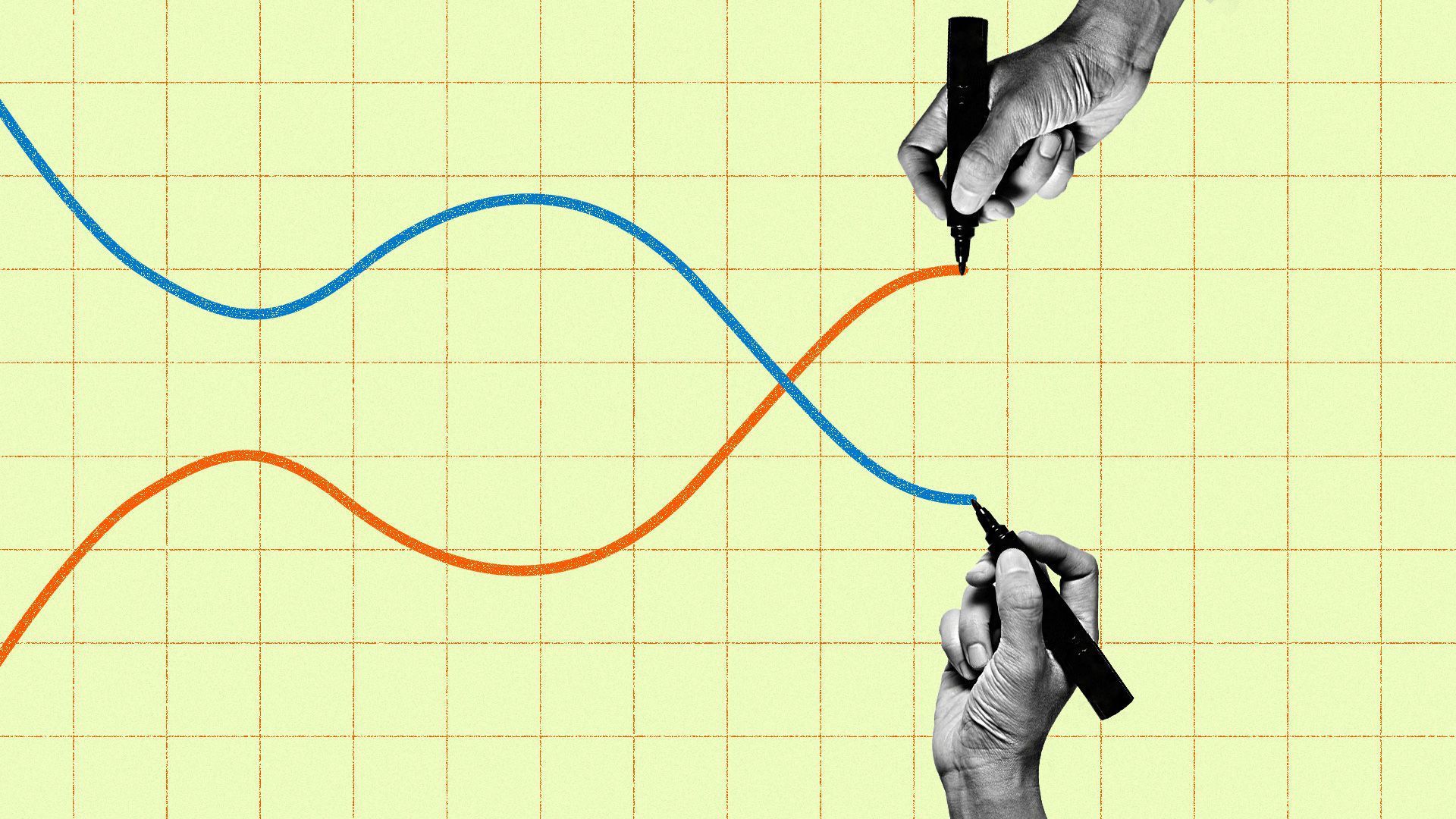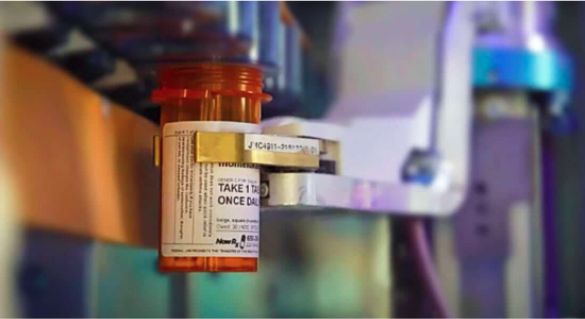| | | | | | | Presented By NowRx | | | | Axios Markets | | By Matt Phillips and Emily Peck ·Mar 29, 2022 | | 👋 Good morning! We're grateful to be out here on a Tuesday knowing we did not do a $591 million whoopsie. 🚊 🏢 Today, Matt's gonna tell you about a slow-moving train wreck in real estate. Plus, there's bond-yield drama and a little bit about interest rates on savings accounts, for a treat, at the end. Let's do this! Today's newsletter is 1,112 words, a 4½-minute read. | | | | | | 1 big thing: 🏙 Cracks in the foundation |  Data: CoStar, Trepp, Barclays Research; Chart: Kavya Beheraj/Axios More than two years after COVID-19 upended the world of work, signs of a slow-motion crackup in office real estate are emerging, Matt writes. Why it matters: Fresh commercial real estate data suggest that working from home (WFH) is becoming a permanent feature of the American economy, a development that has major implications for everything from housing prices to transportation policy to municipal finance. State of play: Vacancy rates continue to climb in major markets across the country, and signs of distress in loans backed by office buildings appear to be growing. - Barclays analysts noted last week that the share of office mortgages that have been assigned to either "watchlists" of loans showing signs of being in trouble or "special servicing," where loans with missed payments are sent, has hit more than 21%. That's the highest since the financial crisis.
- "That's an indication that something not great might be starting to bubble up within the office sector," Lea Overby, a Barclays analyst covering the commercial mortgage market, tells Axios.
Meanwhile, troubling anecdotes are also starting to surface. - Most recently, private equity giant Blackstone stopped making payments on a loan backing a 600,000-square-foot art deco office tower in midtown Manhattan. The building, 1740 Broadway, is expected to be nearly empty next year after the main tenant, troubled retailer L Brands, decided not to renew its lease.
- Blackstone told Axios in an emailed statement that the building "faces a unique set of challenges," adding that "we continue to be big believers in New York and cities like it that are hubs for innovation and talent."
The big picture: Loads of people who started WFH during the pandemic aren't going back. - Nationwide, office vacancy rates rates have risen to 12.2% from 9.7% over the past two years, according to Barclays, which cited data from Costar, a commercial real estate database.
- Those numbers likely overstate how much of that office space is actually being used. Recent data from Kastle Systems, which measure occupancy by looking at foot traffic into offices, showed vacancies of about 60% in major markets.
The bottom line: The office real estate market isn't going to collapse overnight, as leases on commercial office space often lock tenants in for as long as 10 years. - But trends suggest that American office space — along with the economy as a whole — is going to see significant change for years to come.
|     | | | | | | 2. Catch up quick | | 📦 Threat of fresh supply chain woes on the West Coast. (NYT) 🗄 AIG filed for an IPO of its life insurance business. (FT) 🙅♂️ G7 said it won't pay rubles for Russian gas. (AP) ❤️ Will Smith apologized for the Slap. (Axios) |     | | | | | | 3. Warped curve |  | | | Illustration: Lazaro Gamio/Axios | | | | Gyrating bond yields are warping the yield curve, an effect that's becoming more pronounced, and its implications more confusing, Axios' Javier David reports. - Investors are bidding up shorter-dated interest rates more than longer-dated, a condition known as a flattening yield curve, which Matt warned last week is a recessionary bellwether.
Why it matters: Skyrocketing prices have turned the Federal Reserve into inflation firefighters, while geopolitics is pressuring longer term growth forecasts. - Investors are digesting so much that markets are getting indigestion — making it harder to cleanly decipher the yield curve's messages.
What's happening: Yesterday, the difference between the 2-year Treasury and its 10-year counterpart narrowed to its smallest since February 2020. - And the differential between 5-year notes and 30-year bonds actually inverted, which is when it costs the government more to borrow for the shorter period (in this case, five years) than for the longer term.
Between the lines: It's the first time the 5-year and 30-year have inverted since March 2006, Bleakley Advisory CIO Peter Boockvar wrote in a note to clients. - Boockvar contended that an economic "soft landing is wishful thinking," given surging inflation and supply chains that are still under pressure.
Yes, but: The relationship between an inverted yield curve and a possible downturn comes with a lag, economists say. And yield signals are being largely distorted by years of the Fed's aggressive easy money policies. The bottom line: Today's inverted curve doesn't mean tomorrow's recession, but it certainly bears close monitoring. |     | | | | | | A message from NowRx | | A tech-powered investment even a bear would love | | |  | | | | No matter what the future holds, people always need their meds. That's what makes NowRx's tech-powered pharmacy a solid investment. Using software and robotics to operate at a fraction of the cost of major chains, NowRx delivers medications same day, for free. Learn more and invest in NowRx. | | | | | | 4. 🧐 How banks react to rising rates |  Data: Bankrate; Chart: Baidi Wang/Axios Since the Fed started raising rates earlier this month, banks wasted little time pushing up the rates they charge credit card holders on their balances. But when it comes to the interest that folks earn on their savings accounts — those rates aren't budging much, Emily writes. Why it matters: Time to play another round of "banks win, people lose." Financial institutions can earn more on credit card debt and regular folks can watch inflation erode their savings. The big picture: "There typically is a lag between when banks raise interest rates on loans and other assets and when they raise rates on liabilities, particularly on retail checking and savings accounts," says Gary Schlossberg, global strategist at Wells Fargo Investment Institute. - Plus, right now the bigger banks don't really need your money, so they don't have much incentive to raise interest rates to attract more deposits, says Ted Rossman, an analyst at Bankrate.
At the same time, the number of people actually carrying a balance on their credit cards has declined, something executives keep mentioning on their earnings calls. So banks need to get more money from those who do have debt. What's next: Online-only banks are the ones most likely to raise rates on bank accounts, Rossman says. "It's a form of advertising for them." - Online-only Comenity Direct is offering .75% APR on a savings account — the highest tracked by Bankrate, he adds.
|     | | |  | | | | If you like this newsletter, your friends may, too! Refer your friends and get free Axios swag when they sign up. | | | | | | | | 5. Why women outearn men, in some cities |  Pew Research Center analysis of 2015-19 American Community Survey(IPUMS); Chart: Baidi Wang/Axios Women under 30 outearned men in 22 cities across the country, including New York and Washington, D.C., a Pew Research analysis of Census data through 2019 finds, Emily writes. Why it matters: The gender wage penalty is less severe when women are just starting out in their careers. Women age 16–29 earn 93%, on average, of what men make, compared with 84% for all women. - In the other 228 cities Pew analyzed, young women earned less than men.
Between the lines: The 22 cities where women are getting ahead generally have plenty of jobs that require higher levels of education, says Marianne Cooper, a sociologist at Stanford who studies women and leadership. And women have been earning more college degrees than men for decades. The big picture: This edge in pay likely won't last as these women grow older. Women are promoted at a slower pace, Cooper says. And those who have children typically face a wage penalty. (Fathers usually get a wage bump.) Yes, but: This data is from 2015–2019, and women's wages have actually been rising faster than men's lately, as a labor shortage pushes up pay. |     | | | | | | A message from NowRx | | A tech-powered investment even a bear would love | | |  | | | | People will always need to get their meds, making NowRx's tech-powered pharmacy a solid investment. Even in a bear market. Now, with over $26 million in annualized revenue, NowRx is poised for national expansion in 2022. Join over 10,000 others and invest in NowRx today. | | |  | It's called Smart Brevity®. Over 200 orgs use it — in a tool called Axios HQ — to drive productivity with clearer workplace communications. | | | | | | Axios thanks our partners for supporting our newsletters. If you're interested in advertising, learn more here.
Sponsorship has no influence on editorial content. Axios, 3100 Clarendon Blvd, Suite 1300, Arlington VA 22201 | | | You received this email because you signed up for newsletters from Axios.
Change your preferences or unsubscribe here. | | | Was this email forwarded to you?
Sign up now to get Axios in your inbox. | | | | Follow Axios on social media:    | | | | | |












No comments:
Post a Comment